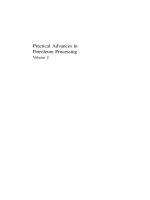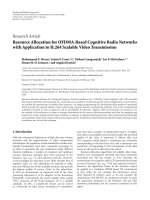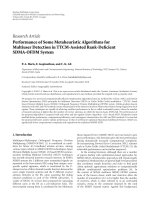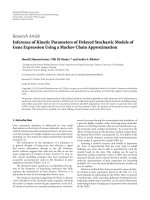Hindawi Publishing Corporation EURASIP Journal on Advances in Signal Processing Volume 2008, Article docx
Bạn đang xem bản rút gọn của tài liệu. Xem và tải ngay bản đầy đủ của tài liệu tại đây (419.83 KB, 2 trang )
Hindawi Publishing Corporation
EURASIP Journal on Advances in Signal Processing
Volume 2008, Article ID 293453, 2 pages
doi:10.1155/2008/293453
Editorial
Human-Activity Analysis in Multimedia Data
A. Enis Cetin,
1
Eric Pauwels,
2
and Ovidio Salvetti
3
1
Department of Electrical and Electronics Engineering, Bilkent University, Ankara 06800, Turkey
2
Signals and Images Research Group, Centre for Mathematics and Computer Science (CWI), 1098 SJ Amsterdam, The Netherlands
3
Institute of Information Science and Technologies (ISTI), Italian National Research Council (CNR), 56124 Pisa, Italy
Correspondence should be addressed to A. Enis Cetin,
Received 11 November 2007; Accepted 11 November 2007
Copyright © 2008 A. Enis Cetin et al. This is an open access article distributed under the Creative Commons Attribution License,
which permits unrestricted use, distribution, and reproduction in any medium, provided the original work is properly cited.
Many important applications in multimedia revolve around
the detection of humans and the interpretation of their be-
havior. These include surveillance and intrusion detection,
video conferencing applications, assisted living applications,
and automatic analysis of sports videos, broadcasts, and
movies, to name just a few. Success in these tasks often re-
quires the integration of various sensor or data modalities
such as video, audio, motion, and accompanying text, and
typically hinges on a host of machine-learning methodolo-
gies to handle the inherent variability and complexity of the
ensuing features. The computational efficiency of the result-
ing algorithms is critical since the amount of data to be pro-
cessed in multimedia applications is typically large, and in
real-time systems, speed is of the essence.
There have been several recent special issues dealing with
the dection of humans and the analysis of their activity re-
lying solely on video footage. In this special issue, we have
tried to provide a platform to contributions that make use
of a broader spectrum of multimedia information, comple-
menting video with audio or text information as well as other
types of sensor signals, whenever available.
The first group of papers in the special issue addresses
the joint use of audio and video data. The paper “Audio-
visual head orientation estimation with particle filter ing in
multisensor scenarios” by C. Canton-Ferrer et al. describes
a multimodal approach to head pose estimation of individ-
uals in environments equipped with multiple cameras and
microphonessuchassmartroomsforautomaticvideocon-
ferencing. The fusion of audio and vision is based on particle
filtering.
S. Shivappa et al., in the paper “An
˙
iterative decoding al-
gorithm for fusion of multimodal
˙
information,” present an
algorithm for speech segmentation in a meeting room sce-
nario using both audio and visual cues. The authors put for-
ward an iterative fusing algorithm that takes advantage of the
theory of turbo codes in communications theory by estab-
lishing an analogy between the redundant parity bits of the
constituent codes of a turbo code and the information from
different sensors in a multimodal system. Dimoulas et al., in
the paper “Joint wavelet video denoising and motion activ-
ity detection in multimodal human activity analysis: applica-
tion to video-assisted bioacoustic/psychophysiological mon-
itoring,” also integrate both audio and video information to
develop a video-assisted biomedical monitoring system that
has been tested for the noninvasive diagnosis of gastrointesti-
nal motility dysfunctions.
The articles by N. Ince et al., titled “Detection of early
morning daily activities with static home and wearable wire-
less sensors,” and B. Toreyin et al., titled “Falling person de-
tection using multisensor signal processing,” are concerned
with indoor monitoring and surveillance applications that
rely on the integration of sensor data. N. Ince et al. de-
scribe a human activity monitoring system to assist patients
with cognitive impairments caused by traumatic brain in-
jury. The article details how fixed motion sensors combined
with accelerometer embedded in wearable wireless sensors
allow the system to detect and classify daily morning activity.
B. Toreyin et al. outline a smart room application employ-
ing passive infrared and vibration sensors, as well as audio,
to reliably detect a person falling.
The rest of the papers in this issue descr ibe video-based
surveillance applications. F. Porikli et al., in the paper “Ro-
bust abandoned object detection using dual foregrounds,”
detect abandoned objects by estimating dual foreground im-
ages from video recorded in an intelligent building. G. Pieri
and D. Moroni, in the paper “Active video-surveillance based
on stereo and infrared imaging ,” describe a video surveil-
lance system integrating information from regular stereo and
2 EURASIP Journal on Advances in Signal Processing
infrared cameras. They exploit the strengths of both modali-
ties by utilizing the more accurate localization made possible
by the stereo cameras in combination with the improved de-
tection robustness that results from inspecting the IR data.
The article by L. Raskin et al., titled “Using gaussian process
annealing particle filter for 3D human tracking,” tracks hu-
mans in 3D scenes using particle filters. The article by M.
Hossain et al., titled “Edge segment-based automatic video
surveillance,” describes a paper using image edge informa-
tion for automatic video surveillance.
A. Enis Cetin
Eric Pauwels
Ovidio Salvetti









